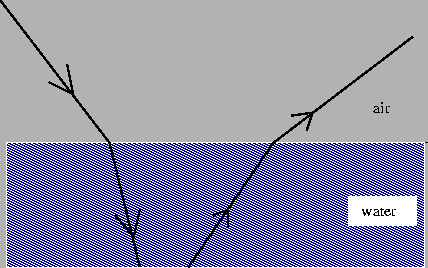




Next: Total internal reflection
Up: Properties of light
Previous: The Speed of Light
Refraction
Another property of light is that it refracts, which means that it
bends when passing from one medium to another. Moreover, when light
enters a more dense medium from one that is less dense, it bends
towards a line normal to the boundary between the two media. This is
illustrated in the figure below.
Figure 10.2:
Refraction of light
 |
The greater the density difference between the two materials, the more
the light bends.
One place where this is
used is in lenses for a variety of optical devices, such as microscopes,
magnifying glasses, and glasses for correcting vision. An example of
an image formed from a lens is shown below.
Figure 10.3:
Image formed from a lens
 |
In this case the light from the object passes through the lens and is
bent, forming an image on the other side of the lens which is magnified
and inverted.
Many types of optical illusions are due, at least in part, to the refraction
of light. One such example is the fact that if you look down
while standing in a swimming pool, your feet appear closer to the
surface than they actually are. This is due to the fact that light is
bent when passing from water to air, as indicated below. Note that
since air is less dense than water, the light bends away from the
normal as it emerges.
Figure 10.4:
Apparent depth of an object under water
 |
The illusion comes from the fact that our eye doesn't know that the light
has been refracted when it comes from water into air,
and so thinks that it has originated from a point closer to the surface.





Next: Total internal reflection
Up: Properties of light
Previous: The Speed of Light
modtech@theory.uwinnipeg.ca
1999-09-29
